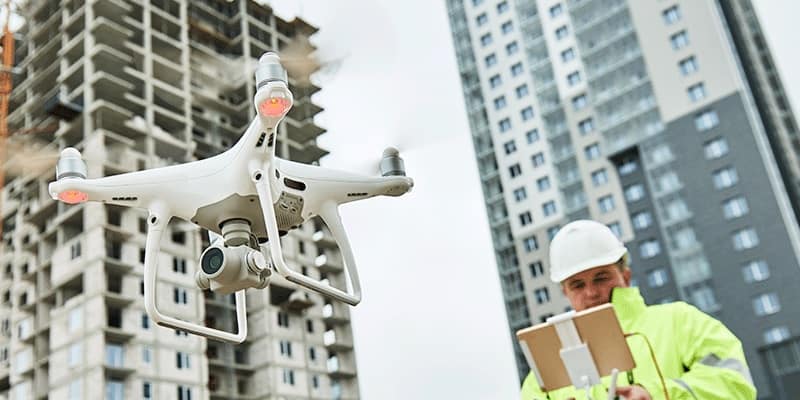
Technology continues to have a dramatic impact on businesses everywhere, including construction. Building greater efficiency is always the goal, and there are innumerable construction technology examples that demonstrate how computer technology, wireless networking, and other solutions reduce costs and shorten time-to-completion, which means more profit for general contractors.
With the aid of new construction technologies, decision-making is becoming more precise as well. There is more data available now than ever before, and new analytics for data-driven decision-making are streamlining every aspect of building design and construction. Here are a few construction technology examples that illustrate how construction is becoming more efficient.
Table of Contents
Computer-aided design and manufacturing (CAD/CAM) has been around for a while, but as computers become more sophisticated, so does computer-aided building design. The latest Building Information Management (BIM) systems enable better collaboration between all stakeholders in a design project. Architects, engineers, contractors, and subcontractors can share computerized building plans in real time, assessing construction options and solving design problems, such as plumbing and HVAC conduit competing for the same space. Being able to create a three-dimensional rendering of a project before you even break ground improves efficiencies across the board, including setting construction deadlines, scheduling workers and subcontractors, and ordering materials.
Using BIM for project modeling makes it easier to track change orders and ensure that everyone is working with the latest version of the building plan. It also simplifies other building tasks, such as ordering prefabricated systems, which can shorten construction time and cut costs. BIM technology also makes it easier to identify where custom components may need to be created using 3D printing.
BIM is a great construction technology example that illustrates how various innovations can come together to make building design and construction more efficient.
Virtual reality and augmented reality (VR/AR) are playing a more significant role in construction, allowing architects and contractors to project themselves into a space under construction, even while it is still on the drawing board. VR/AR makes it easy to create a three-dimensional view of the completed structure and identify design coordination errors. For example, it can be used to validate BIM designs and allow stakeholders to collaborate by actually standing inside a 3D virtual model.
Experts predict that AR systems will improve efficiency throughout the building process, consolidating data from smart helmets and mobile applications to reveal issues with construction processes. It’s also an ideal solution for safety training.
We are already seeing examples of machine automation taking some of the drudgery out of construction. Robots are increasingly being used on job sites to take over repetitive tasks. For example, an automated bricklayer can lay 1,000 bricks per hour without having to stop. Another robot from Japan is designed to install drywall. Automation is certainly one way to tackle the ongoing construction labor shortage.
Heavy machinery can be programmed to perform tasks on their own, using data from built-in sensors and 3D modeling to provide instructions. Siemens is even experimenting with spider robots that combine built-in sensors and 3D printing to speed construction.
Of course, drones have started to become commonplace on the job site. Not only are they useful for aerial views or work in progress, but they can also be used for building inspection in hard-to-reach locations to improve safety.
In the quest for better data-driven decision-making, contractors will make more use of artificial intelligence (AI) and machine learning. AI can be used to improve productivity by tracking jobsite activity and identifying inefficiencies and safety hazards. For example, using sensors on workers, equipment, and materials can track movement around the job site to find out where to place tools to improve efficiency.
Using data gathered from sensors, automated equipment, and drones, AI also can be used to measure how much progress is being made each day. Over time, that data will reveal patterns that can be analyzed to improve efficiency. It also will provide a rich source of analytic data to predict highly accurate outcomes that can be used to improve scheduling, estimating, and bidding.
Another construction technology example that increases efficiency and reduces costs is estimating and reporting software. In the past, construction projects were plagued with inaccurate estimates and errors in manual reporting. Using a software platform like ProEst that is designed specifically for cost estimating eliminates error-ridden spreadsheets and is faster and more accurate than manual processes.
Computerizing cost estimates, reporting, and takeoffs make it possible to store all the relevant data in one location so there is no risk of inaccurate duplicates. With cloud computing, it’s easier to create a central data repository so the latest estimates and reports are always available. It can also quickly create highly accurate takeoffs and increase profits by cutting the time required for reworks and RFIs.
These are just five construction technology examples that illustrate how builders and general contractors can streamline operations and be more efficient in any job. Data powers today’s construction market, and the more data you can accumulate, the more accurate the analyses, the greater the efficiencies, and the bigger the profits. As cloud-driven technology continues to shape the construction industry, the only direction that building efficiency can go is up.
ProEst is a cloud-based pre-construction estimating platform that helps you create accurate estimates and digital takeoffs directly from blueprints quickly, allowing you to determine the most favorable rates for your company within the estimation process. There’s no guesswork involved. ProEst makes quality project estimation assurance in commercial construction companies effortless. You won’t have to engage your entire team to be sure your numbers are accurate.
To learn more about how your commercial construction company can increase its profits through company-wide alignment that drastically improves business performance, reach out today and schedule a 1-on-1 walkthrough with one of our specialists!